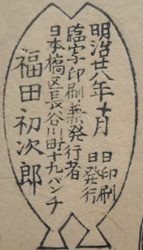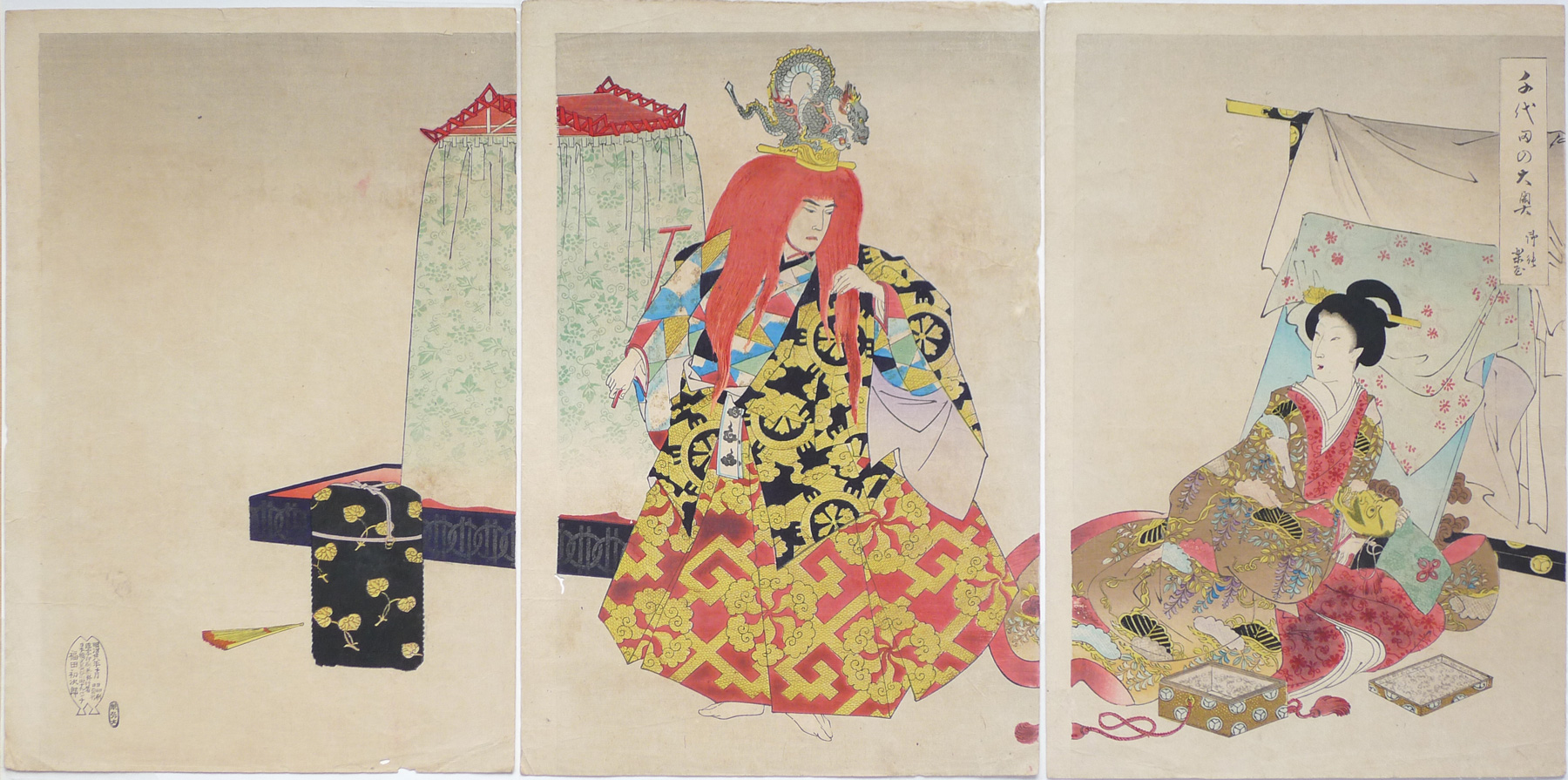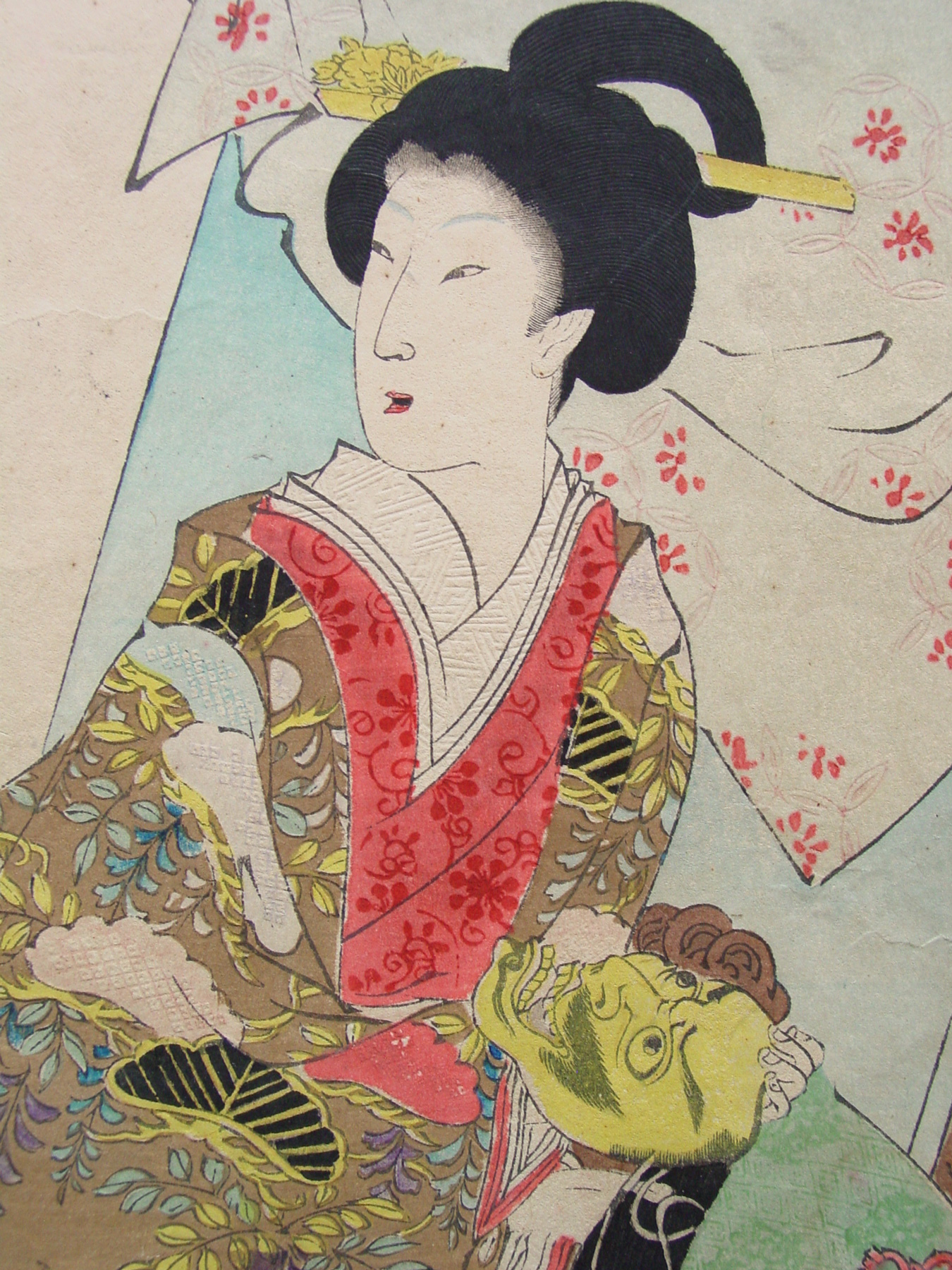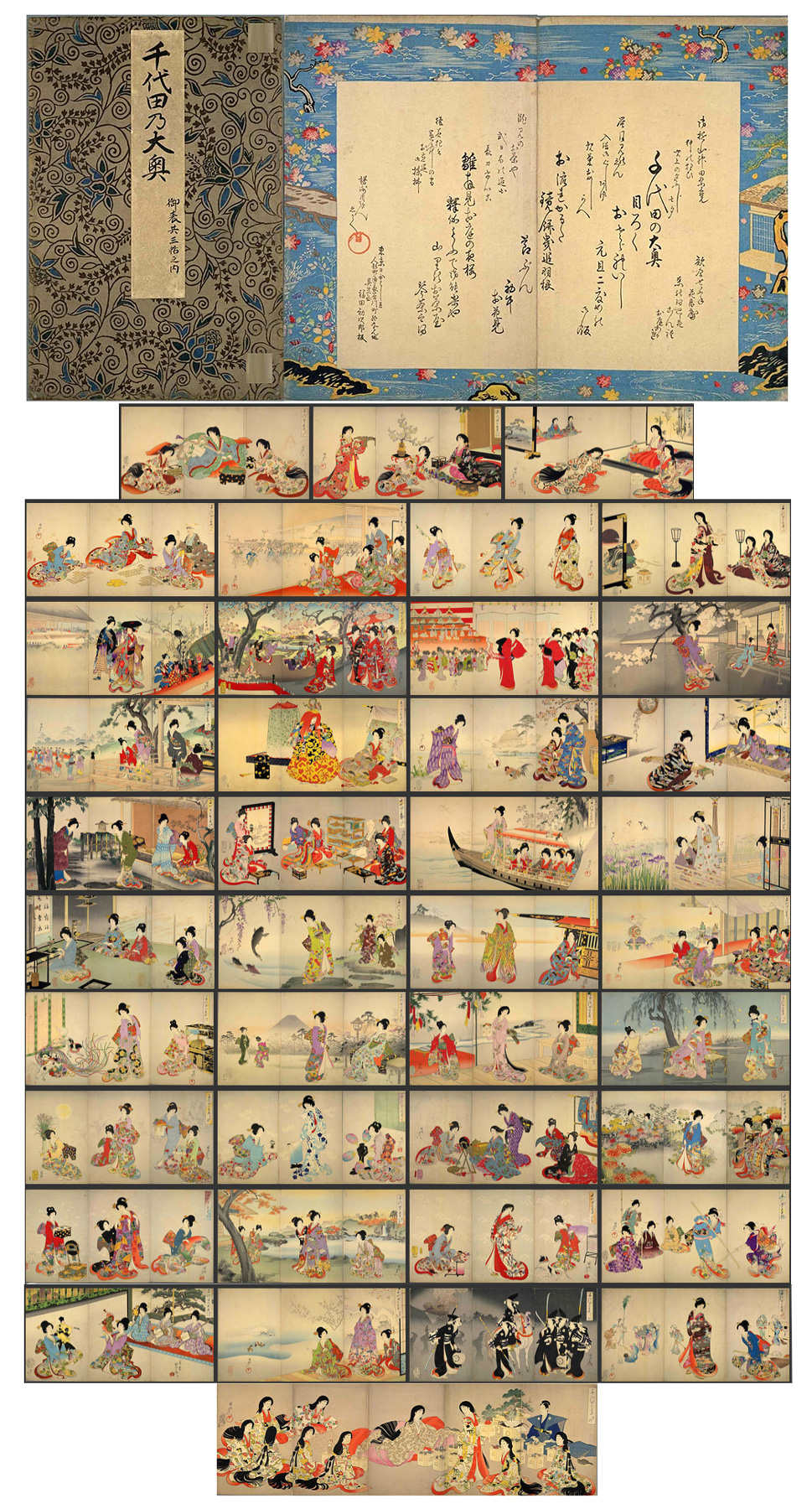About This Print
This print is from a series of 40 scenes, published 1895-1896, documenting life inside the women quarters of the shogun's palace in Edo, prior to the Meiji Restoration in 1868. A lady in waiting hands a noh mask to an actor in the Chiyoda Palace before a performance.1 Extensive use is made of burnishing [shomen zuri (front printing)] which leaves a reflective-polished finish on the black areas and embossing which is seen in the white areas of the lady's robes.
Life in the Palace
Source: Secrets of the Shogun's Harem, Leslie Downer http://www.lesleydowner.com/journalism/secrets-of-the-shoguns-harem/The palace was a world in itself, with woods and gardens, streams and red-lacquered pleasure barges. There the women amused themselves with poetry-writing competitions, tea ceremonies, the incense-guessing game and the shell-matching game. They performed plays and masques and observed the annual festivals, feasting under the cherry blossoms in spring, performing graceful dances at the height of summer and picking mushrooms in autumn.
click on image to enlarge After completion of the series in 1896 the publisher compiled albums of all forty prints, plus a table of contents. | "In the series "The Inner Precincts of Chiyoda," Chikanobu imagines something he never saw—the inner precincts of Edo Castle, which housed the shogun’s mother, wife, and concubines. The area was off limits to all men other than the shogun himself or his young male heir."2 "The Chiyoda Inner Palace (Chiyoda no Ōoku) series of 1895-1896, together with his 1897 series Chiyoda Outer Palace (Chiyoda no on-omote) provided detailed depictions of life in and around Edo Castle before the Meiji Restoration of 1868. In the Chiyoda Inner Palace set, Chikanobu documented various annual ceremonies in the women’s quarters, especially those at New Year’s, and seasonal activities, particularly those conducted in the palace gardens. While Chikanobu did not indicate specific events or name certain people that would link these images to a single date or time period, the scenes give an overall impression of what the shogun’s private quarters might have looked like in the mid-19th century. "Most women depicted in Chiyoda Inner Palace are portrayed as elegant dignified ideal feminine figures, showing little emotion or excitement. No one seems happy or sad, ebullient or upset. In fact, these imaginary depictions suggest a realm of tranquil harmony, without conflict or illness. Only two old women are shown, and most of the more than 150 featured figures are youthful looking, appearing to be in their 20’s or early 30’s. A few girls are present, but even they are well behaved; no babies or pregnant women are evident. There is a sense of tension among the women, though, as ritual gestures and prescribed ceremonies are carried out with great seriousness. Although some settings are animated by secondary figures (servants, |
Chiyoda Palace History
Source: Wikipedia http://en.wikipedia.org/wiki/Edo_CastleChiyoda Castle (千代田城, Chiyoda-jō)also known as Edo Castle (江戸城, Edo-jō), is a flatland castle that was built in 1457 by Ōta Dōkan. It is located in Chiyoda in Tokyo, then known as Edo, Toshima District, Musashi Province. Tokugawa Ieyasu established the Tokugawa shogunate here. It was the residence of the shogun and location of the shogunate, and also functioned as the military capital during the Edo period of Japanese history.
After the capitulation of the shogunate in 1867, the inhabitants including the shogun had to vacate the premises. The castle compound was renamed Tokyo Castle (東京城, Tokyo-jō) in October, 1868, and then renamed Imperial Castle (皇城, Kōjō) in 1869. In the year Meiji 2 (1868), on the 23rd day of the 10th month, the emperor moved to Tokyo and Edo castle became an imperial palace.
1 The play to be performed has been identified as both Chikubushima (The God of The Island of Chikubu) and Kasuga ryujin (The Kasuma Dragon God). Both plays, I believe, use the red wig and dragon helmet.
2 Portland Art Museum http://portlandartmuseum.us/mwebcgi/mweb.exe?request=record;id=46772;type=101
3 Chikanobu – Modernity and Nostalgia in Japanese Prints, Bruce A. Coats, Hotei Publishing, 2006, p. 169.
Print Details
| IHL Catalog | #322 |
| Title or Description | A Lady in Waiting Hands the Noh Mask to an Actor 御能楽屋 |
| Series | Chiyoda Inner Palace Chiyoda no Ōoku 千代田の大奥 |
| Artist | Yōshū Chikanobu (1838-1912) |
| Signature | no signature |
| Seal | no artist's seal |
| Publication Date | October 1895 (Meiji 28) |
| Publisher |  [Marks: pub. ref. 070; seal ref. 062] |
| Carver |  |
| Impression | excellent |
| Colors | excellent |
| Condition | fair – paper thinning and several worm holes; soiling throughout; small loss bottom margin left panel; full-size sheets; unbacked |
| Genre | ukiyo-e |
| Miscellaneous | |
| Format | vertical oban triptych |
| H x W Paper | 14 7/8 x 10 in. (37.8 x 25.4 cm) each sheet |
| H x W Image | 14 1/4 x 9 1/2 in. (36.2 x 24.1 cm) each sheet |
| Literature | |
| Collections This Print | The Metropolitan Museum of Art JP3532; Ritsumeikan University UP1710, 1711, 1712 and ARC 国会668-00-040, 国会668-00-041, 国会668-00-042; Shizuoka Prefectural Central Library K915-108-031-010; National Diet Library NDL call number 寄別8-5-2-1; Scripps College Ruth Chandler Williamson Gallery 2013.1.3 |
4/25/2020




